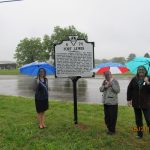Cynthia McKinney | Contributor writer

A historic highway marker noting the site of the former Fort Lewis mansion in Glenvar has been reinstalled, thanks to the efforts of the Fort Lewis Chapter of the Daughters of the American Revolution.
The new sign was unveiled on May 20 on the east side of Rt. 460-Rt. 11, West Main Street. Fort Lewis Chapter members attending were Seyward McKinney, Elizabeth Doolittle, Regent Cynthia “Ricki” McKinney, Shirley Fisher and Chaplain Debbie Taylor, along with State Regent LeAnn Turbyfill. Turbyfill is a former member of the Fort Lewis Chapter.
The chapter raised $1,770 to have the Virginia Department of Historic Resources produce the sign. The former sign – which said “Colonial Mansion Site” – had been felled by a windstorm in 2018.
That sign marked the site of a pre-Revolutionary fort where James Campbell first settled in 1742. It was one of many forts built in the mid-1700s built to protect what then was the frontier. It was originally known as Campbell’s Fort, before being named for Salem’s famous son, Gen. Andrew Lewis.
The prominent White family of Salem built the mansion in 1922. Actor John Payne, who was noted for his role in the movie “Miracle on 34th Street,” lived in the mansion during his childhood. That house burned July 25, 1949.
The original stone historical highway marker was commissioned by the DAR in 1927. The historical marker was one of first in the state. That marker is now displayed at the Virginia Museum of Transportation in downtown Roanoke.
The new marker was ready to be installed by March. Because COVID-19 struck about the same time, chapter members could not attend as a group for the unveiling.
Chapter Regent Ricki McKinney approached the Salem Museum to ask if the unveiling could be included in the museum’s “Around Town” series so that many people could see it. The unveiling video can be seen on the museum’s salem.museum.org webpage, “Salem’s Frontier Fort and Estate,” with host Alex Burke of the Salem Historical Society








